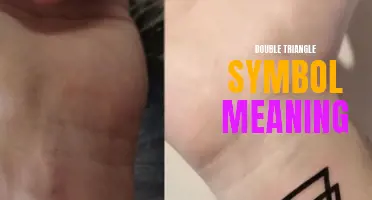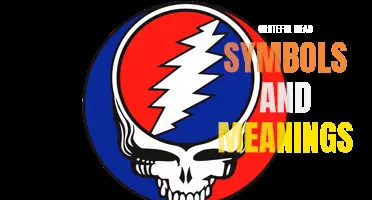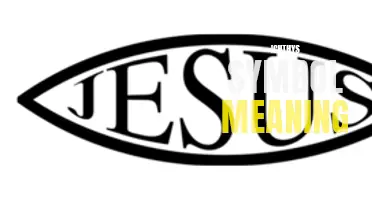
Have you ever noticed that the eye symbol seems to appear almost everywhere, from ancient civilizations to modern-day logos? This intriguing symbol, often associated with protection, wisdom, and knowledge, holds a deep meaning and has captivated cultures and individuals worldwide for centuries. From the all-seeing Eye of Horus in Egyptian mythology to the evil eye amulets in Mediterranean cultures, the eye symbolizes various concepts and ideas depending on its context and cultural background. So, why is this simple yet powerful symbol so pervasive and what does it represent? Join me as we delve into the fascinating world of eye symbols and explore their diverse meanings across different cultures and time periods.
What You'll Learn
- What are some common eye symbols in different cultures and what do they symbolize?
- What is the meaning behind the all-seeing eye symbol and where did it originate?
- Are there any negative or evil connotations associated with eye symbols?
- How have eye symbols been used in art and literature throughout history?
- Are there any specific eye symbols associated with specific deities or mythological figures?

What are some common eye symbols in different cultures and what do they symbolize?
Eyes have long been considered a powerful symbol in various cultures around the world. They are often associated with perception, intuition, and protection. In many societies, different eye symbols are used to convey specific meanings and beliefs. Here are some common eye symbols in different cultures and what they symbolize:
The Eye of Horus - Ancient Egypt:
The Eye of Horus, also known as the Wadjet eye, is one of the most well-known eye symbols in Egyptian culture. It is a symbol of protection, royal power, and good health. The eye is believed to bring about healing and ward off evil spirits.
The Evil Eye - Mediterranean and Middle Eastern Cultures:
The Evil Eye is a widely recognized symbol across Mediterranean and Middle Eastern cultures, including Greek, Turkish, and Arabic. It is typically depicted as a blue eye and is believed to protect against misfortune and ward off evil spirits. The Evil Eye is often worn as a talisman or incorporated in jewelry and home décor.
The Third Eye - Hinduism and Buddhism:
The Third Eye is a symbol commonly associated with Hinduism and Buddhism. It represents spiritual awakening, insight, and enlightenment. In Hindu mythology, the god Shiva is often depicted with a third eye on his forehead, symbolizing his ability to see beyond the physical realm.
The Eye of Providence - Christianity:
The Eye of Providence, commonly known as the "all-seeing eye," is a symbol found in Christianity, particularly in Catholicism. It is often depicted as an eye surrounded by rays of light or a triangle with an eye in the center. The symbol represents the presence and watchful gaze of God, signifying His omniscience and providence.
The Hamsa Hand - Middle Eastern and North African Cultures:
The Hamsa Hand, also known as the Hand of Fatima or Hand of Miriam, is a popular symbol in Middle Eastern and North African cultures. It is believed to bring good luck, protection, and ward off the Evil Eye. The Hamsa Hand often includes an eye symbol in the center, representing divine protection and guidance.
The Eye of Ra - Ancient Egypt:
The Eye of Ra is an ancient Egyptian symbol associated with the sun god Ra. It represents his power and is often depicted as a right eye. The symbol is believed to provide protection, good blessings, and prosperity.
The Eye in the Triangle - Freemasonry:
In Freemasonry, the Eye in the Triangle is a symbol representing the Supreme Being or the Great Architect of the Universe. It is often depicted above a pyramid and symbolizes divine providence and enlightenment. The eye represents divine knowledge and understanding.
These are just a few examples of the different eye symbols found in various cultures around the world. Each symbol carries its own unique meaning and significance, but they all share a common theme of protection, perception, and spirituality. The use of eye symbols in different cultures reflects the universal human desire for guidance, enlightenment, and spiritual connection.
Unlocking the Symbolic Meaning of the Nest: What Does It Represent?
You may want to see also

What is the meaning behind the all-seeing eye symbol and where did it originate?
The all-seeing eye is a symbol that is often associated with mystery, power, and spiritual enlightenment. It is an ancient symbol that has been used in various cultures and religions throughout history. The meaning behind the all-seeing eye symbol is complex and can vary depending on the context in which it is used.
One of the earliest examples of the all-seeing eye symbol can be found in Egyptian mythology. The Eye of Horus, also known as the Wadjet eye, is an ancient Egyptian symbol that represents protection, royalty, and good health. It is often depicted as an eye with a long, curling tail, and it is believed to have the power to ward off evil and bring good fortune.
In Christianity, the all-seeing eye is often associated with the concept of God's omniscience, or the idea that God sees and knows everything. It is seen as a symbol of divine providence and protection. In this context, the all-seeing eye is often depicted as a single eye surrounded by rays of light, representing God's watchful gaze over humanity.
The all-seeing eye symbol is also commonly associated with freemasonry and the Illuminati. In these contexts, the symbol is often interpreted as a representation of a higher power or secret knowledge. It is seen as a symbol of enlightenment, wisdom, and spiritual transformation.
The origins of the all-seeing eye symbol in these secret societies can be traced back to ancient Egypt and the Eye of Horus. The symbol was adopted by various secret societies and used as a metaphor for spiritual enlightenment and knowledge that is hidden from the general public. In freemasonry, the all-seeing eye is often depicted alongside other symbols, such as the square and compass, representing the balance between reason and faith.
In recent years, the all-seeing eye symbol has gained popularity in popular culture and has often been associated with conspiracy theories and secret societies. It is often used in movies, books, and artwork to convey a sense of mystery and intrigue.
In conclusion, the all-seeing eye is a symbol that has been used by various cultures and religions throughout history. Its meaning can vary depending on the context in which it is used, but it is often associated with concepts such as protection, enlightenment, and divine providence. Whether you see it as a symbol of spiritual knowledge or a sign of hidden power, the all-seeing eye continues to captivate and intrigue people around the world.
The Meaning and Symbolism Behind the Hammer: A Powerful Tool with a Deeper Significance
You may want to see also

Are there any negative or evil connotations associated with eye symbols?
Eye symbols have long intrigued and fascinated people throughout history. They can be found in various forms, such as the Eye of Horus, the Eye of Providence, or the Evil Eye. While eye symbols are often associated with protection, insight, and spiritual awareness, there are also negative or evil connotations that have been associated with them.
One of the most well-known negative connotations is the concept of the Evil Eye. The Evil Eye is believed to be a malevolent gaze or glare that has the power to cause harm or misfortune. This belief can be found in many cultures around the world, including Mediterranean, Middle Eastern, and Latin American cultures. According to this belief, certain individuals have the ability to cast the evil eye upon others by simply looking at them with envy or ill will. This negative energy is believed to bring forth bad luck, illness, or other forms of misfortune. For protection against the Evil Eye, people often use eye symbols or amulets to ward off its negative effects.
In some cultures, eye symbols are also associated with dark and mysterious forces. The Eye of Horus, an ancient Egyptian symbol, is believed to have the power to see beyond ordinary perception and protect against evil spirits. However, it is also linked to the god Horus, who was associated with revenge and violence. This duality can be seen in other eye symbols as well. The Eye of Providence, often depicted as an eye within a triangle, is a symbol of divine omniscience and providence in Christianity. However, it has also been associated with conspiracy theories and secret societies, sometimes representing a malicious and controlling force.
In modern popular culture, eye symbols are often used in horror films and literature to create a sense of unease or to represent evil entities. The all-seeing eye, often represented as a single eye with surrounding rays, is a common symbol used to depict a malevolent force that watches and controls everything. This symbol is often associated with secret societies and Illuminati conspiracy theories.
It is important to note that the negative or evil connotations associated with eye symbols are not universal. In many cultures, eye symbols are seen as symbols of protection, wisdom, and spiritual awareness. It ultimately depends on the cultural context and individual beliefs.
In conclusion, while eye symbols are often associated with positive meanings such as protection and insight, there are also negative or evil connotations that have been attached to them throughout history. The belief in the Evil Eye and its ability to bring misfortune or the association of eye symbols with dark and mysterious forces are examples of these negative connotations. However, it is important to understand that these associations are not universal and vary depending on cultural beliefs and individual interpretations.
The Powerful Meanings behind Hex Symbols: Unlocking the Mysteries
You may want to see also

How have eye symbols been used in art and literature throughout history?
Eye symbols have appeared in art and literature throughout history, often carrying deep and symbolic meanings. The proximity of an eye symbol to humans has made it a significant element used by artists and authors to express various ideas and concepts. In this article, we will explore the multifaceted use of eye symbols in different artistic movements and literary works, highlighting their cultural, social, and spiritual significance.
One of the earliest examples of the use of eye symbols can be found in ancient Egyptian art. The "Eye of Horus" was a powerful symbol of protection and good health. It represented the eye of the falcon-headed god Horus and was believed to possess healing and restorative powers. The Eye of Horus was commonly depicted as an isolated eye with distinctive markings, and its popularity has persisted throughout history, even being used in modern tattoo designs.
In Christian art, the "All-Seeing Eye" or "Eye of Providence" has been a recurring motif. Often depicted within a triangle, it represents the watchfulness and omniscience of God. The All-Seeing Eye is commonly associated with religious themes, conveying the idea that God is omnipresent and has knowledge of all things.
In literature, eye symbols have played a significant role in conveying emotions, themes, and character traits. In Fyodor Dostoevsky's novel "Crime and Punishment," the protagonist Raskolnikov has a recurring nightmare where he sees a horse being beaten to death. The horse's eye, described as "wet, intelligent, and kind," symbolizes Raskolnikov's guilt and serves as a reminder of his crime.
Similarly, in J.R.R. Tolkien's "The Lord of the Rings," the character Sauron, the Dark Lord, is often referred to as the "Eye of Sauron." This symbolizes Sauron's control, surveillance, and malevolence. The search for the "One Ring" becomes a quest to avoid falling under the gaze of Sauron and his watchful eye.
In more contemporary works, eye symbols continue to be used to explore deeper meanings. For instance, artist Salvador Dali often incorporated eye symbols in his surrealist paintings. The melting clocks in his famous painting "The Persistence of Memory" are said to resemble eyes, perhaps representing the subjective nature of time and perception.
In conclusion, eye symbols have been used in art and literature throughout history to convey a multitude of messages and ideas. From ancient Egyptian culture to contemporary art movements, the eye symbol has remained a powerful and evocative motif. Whether acting as a symbol of protection, spiritual significance, or exploring deeper psychological themes, eyes continue to captivate artists and authors, making them a timeless and impactful symbol in human creativity.
9 Symbolic Meanings: A Journey into the Depths of Symbolism
You may want to see also

Are there any specific eye symbols associated with specific deities or mythological figures?
Eyes are often seen as windows to the soul and are considered symbols of wisdom, knowledge, and perception. In various mythologies and religions, different deities and mythological figures are associated with specific eye symbols. These symbols can represent various aspects of the divine and hold different meanings depending on the cultural context. Here are a few examples of eye symbols associated with specific deities and mythological figures:
Eye of Horus (Egyptian mythology):
In ancient Egyptian mythology, the Eye of Horus, also known as the Wadjet eye, is a powerful symbol associated with the god Horus. It is often depicted as the right eye and is believed to represent protection, royal power, and good health. This symbol is also connected to the concept of divine light and is seen as a symbol of illumination.
Third Eye (Hinduism and Buddhism):
In both Hinduism and Buddhism, the concept of the "third eye" refers to an inner vision or a heightened level of consciousness. It is often depicted as a mystical eye in the forehead, symbolizing spiritual insight and enlightenment. The third eye is associated with deities like Lord Shiva in Hinduism and with the concept of the Ajna chakra in yoga and meditation practices.
All-Seeing Eye (Various cultures and religions):
The All-Seeing Eye is a symbol found in various cultures and religions, including ancient Egyptian, Christian, and Freemasonry symbolism. It typically depicts an eye surrounded by rays of light or a triangle, representing the watchful gaze of a higher power. In Christianity, it often symbolizes the eye of God or the providence of God overseeing everything.
Nazar (Turkish culture):
The Nazar, also known as the Evil Eye, is a common symbol in Turkish culture and belief systems. It is believed to protect against the evil eye, a malevolent gaze that can cause harm or misfortune. The Nazar is often depicted as a blue eye-shaped amulet or charm and is used as a talisman to ward off negative energy.
Eye of Providence (Masonic symbolism):
In Freemasonry symbolism, the Eye of Providence is a widely recognized symbol associated with divine providence and spiritual insight. It is often depicted as an eye within a triangle and is believed to represent the presence and guidance of a higher power. This symbol is often associated with enlightenment and self-improvement.
These are just a few examples of the many eye symbols associated with specific deities and mythological figures. Each symbol holds its own significance and meaning within its respective cultural or religious context. Overall, these eye symbols serve as reminders of the divine presence, knowledge, and spiritual insight.
Unveiling the Profound November Meaning and Symbolism
You may want to see also
Frequently asked questions
The eye of Horus, also known as the Udjat or the Eye of Ra, is an ancient Egyptian symbol. It represents protection, power, and good health. It is said to bring about healing and provide divine guidance to those who wear it or use it as an amulet.
The evil eye symbol is believed to protect against negative energy and bad luck. It is commonly used in many cultures and religions around the world, such as Islam, Judaism, and Hinduism. The symbol is often worn as a pendant or displayed in homes to ward off evil spirits and protect against curses.
The third eye is a symbol of spiritual enlightenment and intuitive perception. It is often associated with the Ajna chakra, which is believed to be located in the middle of the forehead. The third eye is said to bring about enhanced perception, insight, and awareness of hidden truths. It is also associated with inner peace and spiritual awakening.







